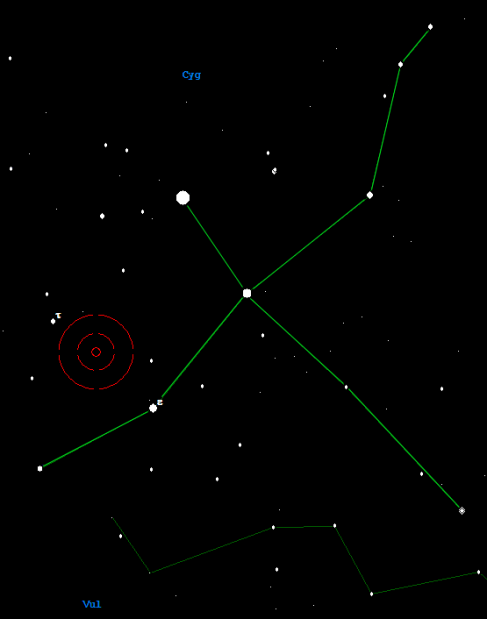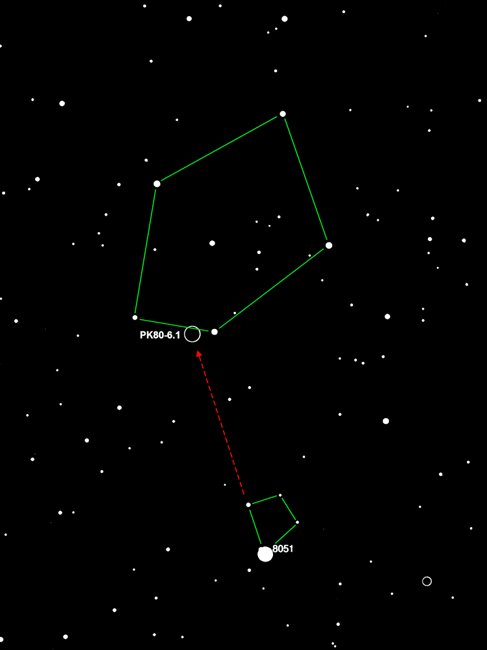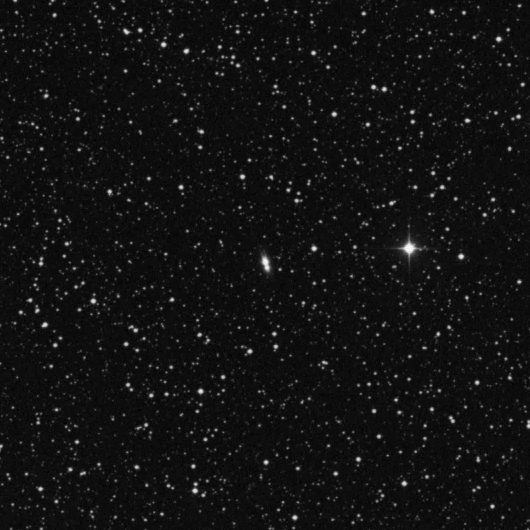To
appreciate this story, you have to set your wayback machine to 2007. That year I
attended the Okie-Tex Star Party along with Mark Deprest, Robert Wade, and
Nathan Murphy. Okie-Tex is a truly remarkable star party that boasts some of
the darkest skies found anywhere in the continental
I
won’t go into much detail on the ‘07 OTSP, but if you are curious you can read
about it here:
http://www.umich.edu/~lowbrows/reflections/2007/dscobel.28.html
So
on to the egg hunt. Nathan decided one night that he’d choose a page of the
Pocket Sky Atlas and see what he could see on it. Now I couldn’t read his mind,
but I’m sure that his thought process went something like this: “Let’s see, what’s
up high right now? Hmm, Cygnus is nearly directly overhead, but I have the
10-inch Portaball, so there’s no such thing as Dobson’s Hole
with that scope. Yeah, let’s try Cygnus.” So he opens the PSA to Cygnus, and
continues. “Let’s see, here’s a nice looking planetary, the ‘Egg Nebula’. Hmm,
if it’s in the PSA, it must be relatively easy, especially considering I’m
under the darkest skies in the country, and I have a ten-inch scope. How hard
can it be?” How hard can it be? Plenty hard as it turned out. Half an hour
later, I’m sure Nathan is thinking thoughts that I cannot share here. Let’s
just say that he was very frustrated at not being able to find something that “ought
to be easy”. In desperation he turns to the rest of us to enlist our help. I
look at the page in PSA. “Looks like it should be a nice little planetary” I
think to myself. “OK, how hard can it be?” I line up the Telrad, and look
though my trusty old 13” Dob named Papa Smurf. Nothing. Pan around some. Nothing. Get out the oxygen-III filter and blink it in and
out. Still nothing. Pan around some, go back to the
starting point, blink the O-III in and out, pan some more, blink, pan, start
over, etc., etc., etc. Still
nothing. What the heck? OK,
time to get out the big gun, Millennium Star Atlas. Find the chart,
there it is, try again. Nothing. OK, go back to Millennium
Star Atlas. There’s a little pentagon-shaped asterism, and the nebula is on one
of the five sides of the pentagon. Find the pentagon, find the nebula. Back to
the scope and pan around the dense star field in Cygnus, which is already dense
because the Milky Way runs right through it, but is rendered even
more so because of the extremely dark sky. “Dang, there are a lot of stars up there!” After a good 20 minutes, I finally
find the little pentagon in a low-power, wide-field eyepiece. “The nebula
should be right there. Where is it?” Blink the O-III in and out. “STILL NOTHING! WHAT IS GOING ON?” Everything dims
equally and there’s no sign of a nebula. All I see is a close, dim, double star
where the nebula ought to be. “OK, let’s zoom in.” At higher magnification the
confounded egg finally reveals itself! The close, dim, double star is actually
enveloped in nebulosity. Finally, success, if you call finding an object after
an hour’s worth of searching “success”. Since that time we’ve unaffectionately
referred to the Egg Nebula as Nathan’s Nemesis and Murphy’s Bane, which are certainly
more descriptive names based on our experience. That sure was one tough little
bugger! But we found it.

At the
2007 OTSP, Nathan looks to be a little edgy after wrestling with the Egg Nebula
last night. Guess who won.
Okay,
back to the present. We’re at CLEAR IV in
Despite
Yasu not being available to see it, this story has a silver lining. I now know
a sure-fire way to star-hop to it quickly, and I think you can do it too. Even
from less than perfect skies.
Start
with the Pocket Sky Atlas, chart number 62, or virtually any other star atlas,
or just Chart 1 shown here. Put your Telrad midway on a line between magnitude
3.7 Tau Cygni and magnitude 2.5 Epsilon Cygni. Now adjust your scope so that the Telrad’s bull’s-eye is just a smidge north of the midpoint of the line. Now look in the
lowest power eyepiece you have. Near the center of the field you should be able
to easily find the double star Yale BSC 8051 (BSC = Bright Star Catalog), whose
components are separated by about 1.2 arc-minutes and are of magnitudes 6.0 and
8.7. Chart 1 shows where to put the Telrad circle.

Chart 1. This
chart shows where to place the Telrad circle, between Tau and Epsilon Cygni.
North is at the top and east is to the left. Chart was generated using Guide
8.0.
That
double star comprises the southernmost corner of a trapezoid of stars that is
angled roughly NNE to SSW, about 9 arc minutes on the longest (SE) side and six
arc minutes on the shortest (NE and NW) sides. Going clockwise from the
brighter double, the star magnitudes are 8.7, 10.0, and 9.8. Chart 2 shows Yale
BSC 8051 and the trapezoid near the bottom of the chart.

Chart 2. This
chart shows the location of the trapezoid north of YBSC 8051, and the pentagon
to its north. The location of the Egg Nebula is circled. North is at the top
and east is to the left. Chart was generated using Guide 8.0.
You
should notice that the first star clockwise (to the NNE) from the bright double
is itself a double star, with components separated by about 45 arc seconds.
These two double stars point almost directly to the nebula, a little more than
half a degree to the NNE. But to be sure that you have the correct field, you
have to find a pentagon of roughly 8th magnitude stars, with a sixth
8th magnitude star in the middle. This pentagon is much larger than
the trapezoid, close to a degree across, and is also shown near the top of Chart
2.
Once
you find the pentagon, finding the Egg is easy. It’s situated along the
southern side of the pentagon, closer to the westernmost star that defines that
side. Once you see what appears to be a faint, close, double star, increase the
magnification to at least 200x. You should see that
the two “stars” are enveloped in nebulosity, and that one of them is slightly brighter
than the other. The image below approximates the appearance
of the nebula in the eyepiece — but remember that it is much brighter in
the image here than it will appear visually.

The Egg
Nebula, PK80-6.1, is at center. Sloan Digital Sky Survey image courtesy the
Space Telescope Science Institute.
There,
you found it! That wasn’t so hard, was it? Maybe I don’t want you to answer
that. After all, I haven’t tried using this method locally under our more
light-polluted skies. But I intend to try next time I’m out.
So
what is the Egg Nebula anyway? It’s marked in both Pocket Sky Atlas and Millennium
Star Atlas as a planetary nebula, but why does it not respond to an O-III
filter? It is thought that the Egg is a proto-planetary nebula. In other words,
a star that is in the process of becoming a planetary nebula, but not quite
yet. The hypothesis is that it is so early in the process of becoming a
planetary nebula that its dusty environment is shining by reflected light which
is over-powering any ionized gas emission.
Here’s
a table with some data on the Egg Nebula. Some sources list it as magnitude
13.5, but from my observations and those of others I’m calling it approximately
visual magnitude 11.5 or 12. That sounds faint but its surface brightness is
quite high due to its very small angular size.
|
Perek-Kohoutek
designation |
PK80-6.1 |
|
Galactic
Nebula designation |
GN
21.00.3 |
|
Coordinates
(epoch 2000) |
RA
21h 02m 19s Dec +36° 41m 38s |
|
Magnitude |
~12 |
|
Size |
~30” |
So,
can you hunt down the elusive Egg? Under pristine skies it should be visible in
a six-inch scope, but under the compromised skies of
